- Knee Arthroscopy

Knee arthroscopy is a common surgical procedure performed using an arthroscope, a viewing instrument, to diagnose or treat a knee problem. It is a relatively safe procedure and you will usually be discharged from the hospital on the same day of surgery.
Know More Launch Movie - ACL Reconstruction

ACL (anterior cruciate ligament) reconstruction is a commonly performed surgical procedure. With recent advances in arthroscopic surgery, it can now be performed with minimal incision and low complication rates.
Know More - Knee Cartilage Restoration

Knee cartilage restoration is a surgical technique to repair damaged articular cartilage in the knee joint by stimulating new growth of cartilage or by transplanting cartilage into areas with defects in order to relieve pain and restore normal function to the knee.
Know More - Meniscal Surgery

Meniscal surgery is a surgical procedure employed for the treatment of torn or damaged meniscal tissues in the knee. It is mostly performed as a minimally invasive keyhole procedure.
Know More - Patellofemoral Knee Replacement

Traditionally, arthritis in only one compartment of the knee is treated by partial knee replacement surgery. Patellofemoral knee replacement is a minimally invasive surgical option performed in the patellofemoral compartment only, preserving the knee parts not damaged by arthritis as well as the stabilizing anterior and posterior cruciate ligaments (ACL and PCL).
Know More - Meniscus Replacement

Meniscus replacement is a surgical procedure performed to replace a torn or damaged meniscus in the knee.
Know More - Cartilage Replacement

Cartilage replacement is a surgical procedure performed to replace the worn-out cartilage with new cartilage.
Know More - PCL Reconstruction
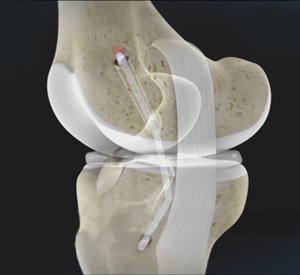
PCL reconstruction surgery is a procedure to correct torn posterior cruciate ligament (PCL) in the knee using a tissue graft taken from another part of the body, or from a donor.
Know More Launch Movie - Knee Ligament Reconstruction

Knee ligament reconstruction is a surgical procedure to repair or replace damaged ligaments of the knee joint. The surgery can be performed using minimally invasive techniques.
Know More - Posterolateral Corner (PLC) Reconstruction

A posterolateral corner is a complex arrangement of multiple ligaments, tendons, muscles and a joint capsule in your knee. It is located on the outside back corner of the knee.
Know More - Revision Knee Ligament Reconstruction

Revision knee ligament reconstruction is a complex surgical procedure performed to address failures or to correct the undesirable consequences of primary reconstruction surgery on your knee.
Know More - Posterolateral Corner Reconstruction

Posterolateral corner injury is damage or injury to the structures of the posterolateral corner. The structures of the posterolateral corner include the lateral collateral ligament, the popliteus tendon, and the popliteo-fibular ligament. Injuries to the posterolateral corner most often occur with athletic trauma, motor-vehicle accidents, and falls.
Know More - LCL Reconstruction

LCL reconstruction is a surgical procedure to repair torn or damaged lateral collateral ligament in the knee using a tissue graft taken from another part of the body, or from a donor.
Know More - MCL Reconstruction

MCL reconstruction is a minimally invasive surgical procedure in which a tendon graft is utilized to reconstruct the injured MCL.
Know More Launch Movie - LPFL Reconstruction

LPFL reconstruction or lateral patellofemoral ligament reconstruction is a surgical procedure employed to treat patients with severe patellofemoral instability.
Know More - Medial Patellofemoral Ligament Reconstruction

The medial patellofemoral ligament is a band of tissue that extends from the femoral medial epicondyle to the superior aspect of the patella. It is a major ligament that stabilizes the patella and helps in preventing patellar subluxation (partial dislocation) or dislocation.
Know More - Quadriceps Tendon Repair

Quadriceps tendon is a thick tissue located at the top of the kneecap.
Know More - Knee Fracture Surgery

A knee fracture is a broken bone or a crack in or around the joint of the knee. This can involve the tibia (shin bone), the kneecap (patella), or femur (thighbone) where they connect with the knee.
Know More - Meniscectomy

Meniscectomy is a surgical procedure indicated in individuals with torn meniscus where the conservative treatments are a failure to relieve the pain and other symptoms. Meniscectomy is recommended based on the ability of meniscus to heal, patient’s age, health status, and activity level.
Know More - Distal Realignment Procedures

Distal realignment procedures, also known as tibial tubercle transfer (TTT) procedures, are performed to reposition the kneecap after subluxation or dislocation by realigning the tendon under the kneecap to the underlying tibial tubercle.
Know More - Partial Arthroscopic Meniscectomy
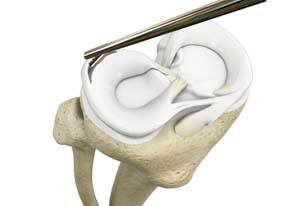
Partial arthroscopic meniscectomy is a procedure to remove the damaged part of a meniscus in the knee joint with the help an arthroscope. The meniscus is a C-shaped disc of cartilage between your thighbone and shinbone. There are 2 menisci in each knee. They act as shock absorbers and provide stability to the joint.
Know More - Patellofemoral Realignment

Patellofemoral realignment is a surgical procedure performed to treat symptomatic patellofemoral instability that does not respond to nonsurgical treatment measures.
Know More - Failed Anterior Cruciate Ligament (ACL) Reconstruction

A revision ACL reconstruction is considered after determining the exact cause for the initial failure. Repeat surgery is performed to improve graft stability and address other comorbidities such as infection and arthrofibrosis. Various alternative techniques, fixatives, and grafts are carefully considered for the revision reconstruction to correct failures of the primary surgery.
Know More - Failed Meniscus Repair

The meniscus is a C-shaped cartilage that functions as a cushion between the long bones of the shin and thigh.
Know More - Lateral Lengthening

Lateral lengthening, also known as lateral retinacular lengthening or release, is a surgical procedure to release a tightened lateral retinaculum on the outer aspect of the knee.
Know More - Meniscal Transplantation
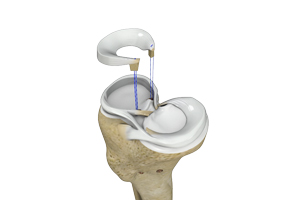
Meniscal transplantation is a surgical procedure to replace the damaged meniscus of the knee with healthy cartilage.
Know More Launch Movie - Prior Meniscectomy

Meniscectomy involves the total or partial removal of the damaged or torn meniscus. It is indicated for horizontal and flap tears, and moderate to large tears at the outer edge of the meniscus. The procedure is performed under regional or general anesthesia, using arthroscopy or open surgery.
Know More - Tibial Eminence Fracture

The tibia or shin bone is a major bone of the leg which connects the knee to the ankle. A fracture or break in the upper part of the tibia is known as a proximal tibial fracture and commonly occurs just below the knee joint.
Know More - ORIF of the Knee Fracture

ORIF refers to open reduction and internal fixation. It is a surgical procedure employed for the treatment of a fracture not amenable to non-surgical conservative treatment.
Know More - Bone-Patellar Tendon-Bone (BPTB) Autograft

ACL reconstruction with BPTP autograft is a surgical procedure that replaces the injured ACL with an autograft containing patellar tendon and bony attachments. The new ACL is harvested from the patellar tendon that connects the bottom of the kneecap (patella) to the top of the shinbone (tibia). The goal of the surgery is to tighten your knee and to restore its stability.
Know More - Bone-Patellar Tendon-Bone (BPTB) Allograft

ACL reconstruction with BPTP allograft is a surgical procedure that replaces the injured ACL with an allograft containing patellar tendon and bony attachments. The goal of the surgery is to tighten your knee and to restore its stability.
Know More - Hamstring Autograft

An autograft refers to using organ or tissue (bone, cartilage, tendon or skin) from the same person to transplant elsewhere on their body.
Know More - Hamstring Allograft

ACL reconstruction hamstring allograft method is a surgical procedure to replace the torn ACL with hamstring allograft. The goal of ACL reconstruction surgery is to tighten your knee and restore its stability.
Know More - Knee Osteotomy

Knee osteotomy is a surgical procedure in which the upper shinbone (tibia) or lower thighbone (femur) is cut and realigned. It is usually performed in arthritic conditions affecting only one side of your knee.
Know More - High Tibial Osteotomy

High tibial osteotomy is a surgical procedure performed to relieve pressure on the damaged site of an arthritic knee joint.
Know More Launch Movie - Tibial Tubercle Osteotomy

Tibial tubercle osteotomy is a surgical procedure that is performed along with other procedures to treat patellar instability, patellofemoral pain, and osteoarthritis.
Know More - Distal Femoral Osteotomy
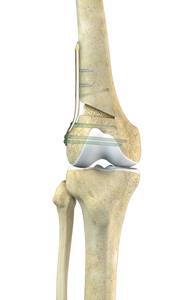
An osteotomy is a surgical procedure that involves cutting of bone. The distal femur is part of the femur (thighbone) just above the knee joint. Distal femoral osteotomy is performed to correct knee alignment which can lead to excessive loading and degeneration of one side of the knee joint.
Know More - Multiligament Reconstruction of the Knee
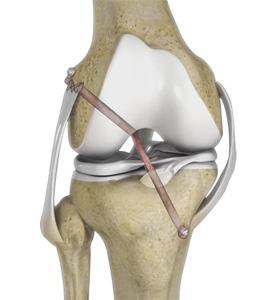
Multiligament knee reconstruction is a surgical procedure to repair or replace two or more damaged ligaments of the knee joint. The surgery can be performed using minimally invasive techniques.
Know More - Patellar Tendon Repair

Patellar tendon repair is the surgery performed to reattach the torn tendon to the kneecap and to restore normal function in the affected leg.
Know More - Arthroscopic Reconstruction of the Knee for Ligament Injuries

Arthroscopic knee ligament reconstruction is a surgical procedure to correct a torn knee ligament by replacing the ligament with a healthy tendon tissue using an arthroscope.
Know More - Autologous Chondrocyte Implantation

Autologous chondrocyte implantation (ACI) is a procedure to treat the articular cartilage defects of the knee. This procedure is effective for treating small areas of cartilage damage that causes pain and swelling and restricts range of motion. Autologous chondrocyte implantation is not indicated if you have advanced arthritis of the knee.
Know More - Partial Meniscectomy

Partial meniscectomy is a surgical procedure to remove the torn portion of the meniscus from the knee joint.
Know More - Cartilage Microfracture

Cartilage microfracture is a surgical procedure performed to replace the worn-out articular cartilage with new cartilage.
Know More - Pharmacological Interventions for Knee Injuries

Pharmacological interventions include medicinal preparations such as pain-relieving capsules or injections.
Know More - Ultrasound-Guided Genicular Nerve Block

The genicular nerves are nerves surrounding your knee joint that are responsible for the transmission of pain impulses. Knee disorders causing excessive pain can be treated by blocking the genicular nerves from transmitting nerve impulses. The procedure may be performed under the guidance of ultrasound imaging.
Know More - Intraarticluar Knee Injection

An intra-articular knee injection is a very effective form of treatment where medicine is delivered directly into the knee joint with the primary objective of relieving pain from conditions such as arthritis.
Know More Launch Movie - Viscosupplementation

Viscosupplementation refers to the injection of a hyaluronan preparation into the joint. Hyaluronan is a natural substance present in the joint fluid that assists in lubrication. It allows the smooth movement of the cartilage-covered articulating surfaces of the joint.
Know More - Physical Therapy for Knee

Physical therapy is an exercise program that helps you to improve movement, relieve pain, encourage blood flow for faster healing, and restore your physical function and fitness level.
Know More








